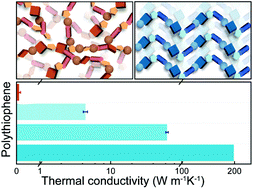State-of-the-art, opportunities, and challenges in bottom-up synthesis of polymers with high thermal conductivity
Abstract
In contrast to metals, polymers are predominantly thermal and electrical insulators. With their unparalleled advantages such as light weight, turning polymer insulators into heat conductors with metal-like thermal conductivity is of substantial interest and technological importance for heat dissipation applications. However, engineering bulk polymers with ultrahigh thermal conductivity remains a difficulty currently. Moreover, thermal transport mechanisms are not fully understood. In this review, we first discuss the present understanding of thermal transport mechanisms in polymers. Then, we discuss various bottom-up strategies aimed at achieving highly thermally conductive polymers with representative examples. We investigate relationships between polymer structures and thermal transport properties. We highlight current challenges within the design and synthesis of highly thermally conductive polymers. We also suggest future endeavors regarding research challenges in thermally conductive polymers. Importantly, we emphasize the potential possibilities and inspiring opportunities for future applications of thermally conductive polymers with metal-like thermal conductivity.

- This article is part of the themed collections: Polymer Chemistry Emerging Investigators Series and Polymer Chemistry Most Popular 2022


 Please wait while we load your content...
Please wait while we load your content...